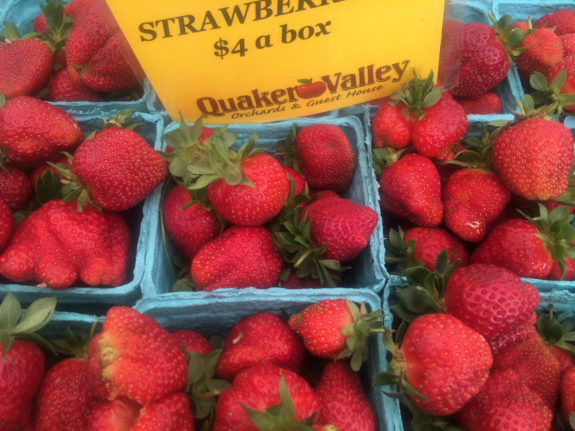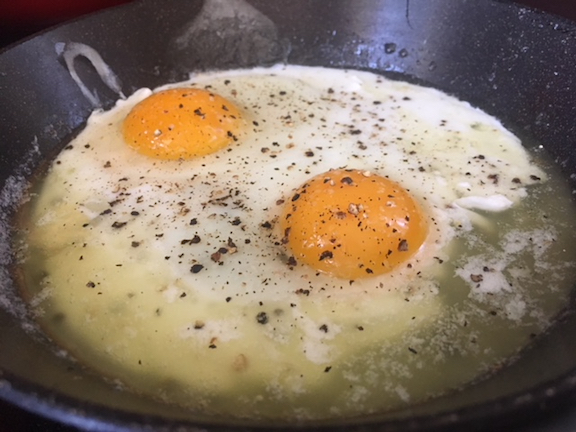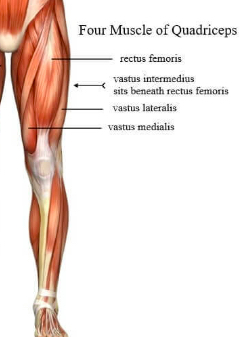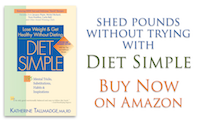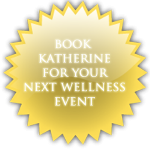Sweet Strawberries! First Fresh, Local Strawberry Salad of the Season!
Strawberries! Strawberries! Strawberries! Come and get your strawberries! I’m surprised the first strawberries of the season are sweet. I stopped by Quaker Valley Orchards at the Dupont Circle Fresh Farm Market on Sunday (as I always do), tasted one, and the sweet juice ran down my arm – a good sign.
Usually the season’s first strawberries aren’t sweet, but these are – and I recommend them – in case you haven’t guessed already. And lucky for us, Quaker Valley also sells their exceptional produce at the Rose Park Farmer’s Market on Wednesdays from 3:00 to 7:00 pm.
Of course, most of the strawberries I bought – 8 pints – will be popped into my mouth as is. But, this salad is also a great way to celebrate strawberries.
Fresh Strawberry Salad with Goat Cheese, Toasted Almonds and a Balsamic Vinaigrette
New World Health Organization Recommendations for Infant & Toddler Wellbeing
- At April 27, 2019
- By Katherine
- In Articles, News
 0
0
The World Health Organization (WHO), an internationally respected United Nations public health agency, issued its first recommendations for sleep, along with exercise and screen time for children under the age of 5. Applying the recommendations during the first 5 years of life will contribute to children’s motor and cognitive developement and lifelong health, according to the WHO.
“Improving physical activity, reducing sedentary time and ensuring quality sleep in young children will improve their physical, mental health and wellbeing, and help prevent childhood obesity and associated diseases later in life,” says Dr. Fiona Bull, program manager for surveillance and population-based prevention of noncommunicable diseases at WHO. The Commission on Ending Childhood Obesity had asked for guidance on physical activity, sedentary behavior and sleep in young children.
Over 23% of adults and 80% of adolescents are not sufficiently physically active. If healthy physical activity, sedentary behavior and sleep habits are established early in life, this helps shape habits through childhood adolescence and into adulthood, according to the WHO.

Children playing is crucial for their health, psychological and physical well-being. It sets them up with good habits later in life and prevents obesity and its related diseases
“What we really need to do is bring back play for children,” says Dr. Juana Willumsen, WHO focal point for childhood obesity and physical activity. “This is about making a shift from sedentary time to playtime, while protecting sleep.”
Recommendations at a glance:
Children less than 1 year of age should:
- Be physically active several times a day in a variety of ways, particularly through interactive floor-based play. For those not yet mobile, this includes at least 30 minutes in prone position (tummy time) spread throughout the day while awake,
- Not be restrained for more than 1 hour at a time. Screen time is not recommended. When sedentary, engaging in reading and story telling with a care-giver is encouraged,
- Have 14 – 17 hours (0 to 3 months of age) or 12 to 16 hours (4 – 11 months of age) of good quality sleep including naps.
Children 1 – 2 years of age should:
- Spend at least 180 minutes in a variety of types of physical activities at any intensity. More is better,
- Not be restrained or sit for more than 1 hour at a time. Also, sedentary screen time is not recommended. At aged 2, sedentary screen time should be no more than 1 hour. Less is better,
- Have 11 to 14 hours of good quality sleep, including naps, with regular sleep and wake-up times.
Children 3 – 4 year of age should:
- Spend at least 180 minutes in a variety of types of physical activity at any intensity, of which at least 60 minutes is moderate to vigorous intensity spread throughout the day. More is better,
- Not to be restrained for more than 1 hour at a time or sit for extended periods. Sedentary screen time would be no more than 1 hour. Less is better,
- Have 10 – 13 hours of good quality sleep.
What Eggsactly is the Story About Egg Safety
- At March 26, 2019
- By Katherine
- In Articles, News
 0
0
The media thrives on hype and its latest target is the egg, a low calorie, inexpensive, source of protein and hard-to-get nutrients.* It is now being blamed for heart attacks and premature death.
Happily, the overwhelming evidence from many well-respected studies show that it is ok to eat an egg.
The media has focused on a single new study published in the Journal of the American Medical Association (JAMA) that concluded: “Among US adults, higher consumption of dietary cholesterol or eggs was significantly associated with higher risk of incident CVD [cardiovascular – heart – disease] and all-cause mortality [all causes of death] in a dose-response manner.”
However, a well-regarded review of 17 studies found that: “Higher consumption of eggs (up to one egg per day) is not associated with increased risk of coronary heart disease or stroke.”
Further, the recent JAMA study has been criticized for its weak design. Indeed, the authors admitted that they could not rule out other foods or lifestyle issues causing the spike in CVD and death rates. For instance, did the subjects eat eggs with buttered white toast or bacon, as people often do? If so, there is a large body of evidence showing that buttered white bread or bacon would be the more likely offenders in spiking CVD or early death.
JAMA study results stated that there is this flaw. It said: “The associations between egg consumption and incident CVD … and all-cause mortality … were no longer significant after adjusting for dietary cholesterol consumption.
In other words, eggs may have had little or nothing to do with increasing CVD risk, while cholesterol may have.
Besides the admitted weakness, in the JAMA study, there are other unanswered questions:
Did the researchers analyze red meat intake? It is well-established that red meat is associated with increased CVD risk and all causes of death, and red meat happens to be high in cholesterol. Could the cholesterol in red meat have been responsible? The JAMA researchers said themselves that they could not tease out all factors leading to the increased CVD and death rates they observed.
Did they analyze saturated fat content? Saturated fat is a more established culprit behind heart disease, according to a Harvard study (among many others) and the American Heart Association.
Cholesterol is in all animal foods. And, we know that foods like red meat are strongly linked to CVD and all causes of death – and are also high in saturated fat.
In short, the JAMA study did not shed any further light on what foods are responsible for increased CVD. While any number of well-respected studies show that it is ok to eat an egg.
* Here are some ways you may benefit from eating eggs…
Protein. Eggs are considered the gold standard against which other proteins are measured. Because of the superior amino acid mix, an egg’s seven grams of protein are absorbed easily and efficiently used by the body. The egg is also low-calorie (74 calories).
Choline. Yolks are one of the best sources of this essential nutrient. Choline is needed for brain development in a growing fetus and may also be important for brain function in adults.
Lutein and Zeaxanthin. These two, important, beneficial nutrients found in egg yolks (as well as kale and spinach) help prevent eye diseases, especially cataracts and age-related macular degeneration. While eggs contain less lutein and zeaxanthin than greens, they are more absorbable because of the presence of fat in the yolk.
Vitamin D. Eggs are one of the few natural sources of Vitamin D, important for the bones, teeth, and possibly reductions in heart disease, cancer and a myriad of other diseases.
Spring Training: Strength Train for Knee Pain
- At March 21, 2019
- By Katherine
- In Articles, News
 0
0
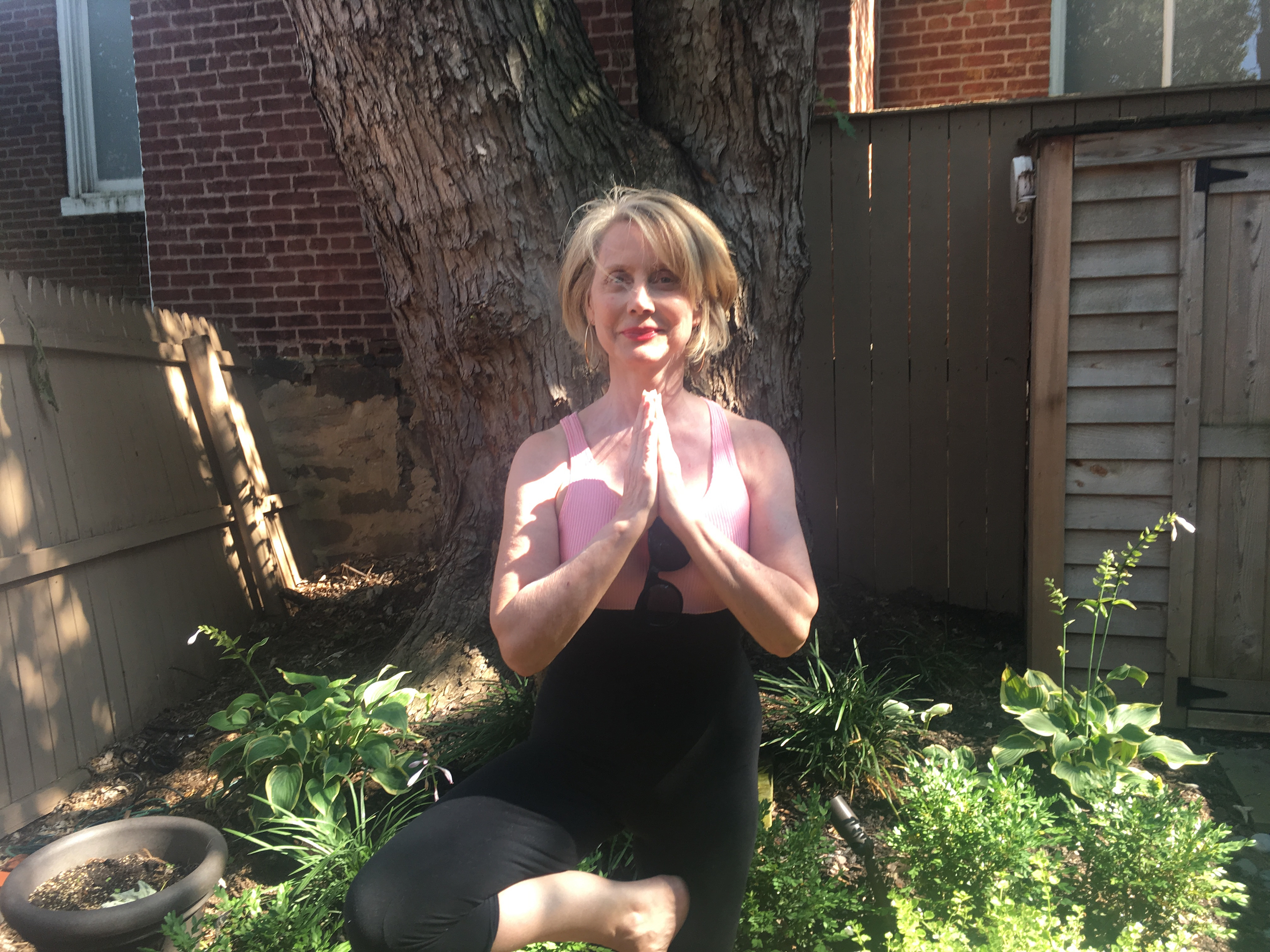 Tree Pose. Ommmmmmmm…
Tree Pose. Ommmmmmmm…
I have knee issues like about everyone else I know. In fact, “about 60 million Americans have knee osteoarthritis and this number will increase by 50% over the next decade,” according to The Journal of Injury, Function, and Rehabilitation. I started feeling little twinges by my early 30’s. Perhaps being a gymnast and a dancer growing up led to early symptoms. No matter, working with physical therapists and trainers over the years averted any serious pain – until recently.
 Three years ago, a torn meniscus required arthroscopic surgery, but my knee pain is back. After some research, I found a review of studies in the journal, BMC Musculoskeletal Disorders, and I learned that certain knee arthroscopic surgery is controversial because apparently, it can hasten knee degeneration. That can lead to the need for knee replacement within just a couple of years. So I can’t help wondering: Should I have undergone the arthroscopic surgery to begin with? There are really no answers. And I can’t look back now.
Three years ago, a torn meniscus required arthroscopic surgery, but my knee pain is back. After some research, I found a review of studies in the journal, BMC Musculoskeletal Disorders, and I learned that certain knee arthroscopic surgery is controversial because apparently, it can hasten knee degeneration. That can lead to the need for knee replacement within just a couple of years. So I can’t help wondering: Should I have undergone the arthroscopic surgery to begin with? There are really no answers. And I can’t look back now.
But I’m feeling hopeful these days. Lots of interesting research is showing that exercising certain muscles with heavier weights, using fewer repetitions (meaning you exhaust your muscle within 8 to 12 reps) can successfully decrease knee pain while increasing function, and that includes longer and stronger walking.
I’m especially convinced about these recommendations because a body of evidence is building that “power training” with heavy weights is most effective at building muscle in older people. That’s because it improves the functioning of the nerves that power muscle, according to a study conducted by the Norwegian University of Science and Technology. The degradation of these nerves is a major cause of muscle impairment in older people, causing disability and loss of independence.
“Improvements in symptoms and function are directly related to exercise intensity and that higher intensity (if maintained over time) would sustain muscle strength and preserve functional abilities,” according to the knee arthritis study. The study continued to state that even with more severe knee arthritis, intense strength training enhances postoperative recovery if knee replacement is necessary.
Quadricep strength is particularly important.
To that end, I’m working with a physical therapist and trainer (periodically), and have invested in (used) weight machines (Craig’s list). I’m exercise biking, and do mat pilates from a YouTube video. It’s amazing how much more easily – and with significantly less pain – I can walk after I exercise.
I urge you to do the same!
Vaccines are Safe!
- At March 08, 2019
- By Katherine
- In Articles, News
 0
0

Vaccines are Safe Based on Decades of Sound Scientific Research, According The National Academies of Sciences, Engineering and Medicine
“The current measles outbreaks in the United States and elsewhere are being fueled by misinformation about the safety of vaccines,” according to warnings issued recently from the Presidents of the National Academies of Sciences, Engineering and Medicine.
To help counter such misinformation, the Academies created a website that provides clear, concise, and evidence-based answers to questions about vaccine safety and other commonly asked questions about health and science as identified through our partnership with Google.
The evidence base includes a number of our studies examining vaccine access, safety, scheduling, and possible side effects. Our work has validated that the science is clear – vaccines are extremely safe, continued the warning from the Academies Presidents.
Given our shared congressional mandate to advise the nation, we are compelled to draw attention to these facts in order to inform better decision-making at a time when it is urgently needed to protect the health of communities in our country and around the world.
Furthermore, we call on our professional colleagues everywhere to share these facts as widely as possible, they added.
To Curb Cravings, Eat a Sweet at Every Meal
- At March 01, 2019
- By Katherine
- In Articles, News
 0
0
My client, Debbie, said sweet cravings were destroying her health and her weight loss attempts. She was “eating practically a box of chocolates every day” and couldn’t stop. And while chocolate fits into a healthy diet – I prescribe daily chocolate for my clients who need to gain weight – the amount she was eating was not helping her high cholesterol, her fatty liver, and was causing her weight to soar higher and higher.
What seemed like an impossible problem was a cinch to fix. All we did was add sweet foods to her routine. You see, your body craves a variety of flavors, textures, colors and shapes, preferably in each meal, to feel satisfied. If one of those flavors, such as sweet, is missing from your meal, you are less likely to feel satisfied and you will crave that missing flavor. Pay attention to your next large savory meal. Even if you are no longer hungry, you will probably crave sweets afterwards. If, on the other hand, you include fruit as a part of your meal, you will crave fewer sweets, which is something I advise in my book, Diet Simple.
Evolution created our drive for food variety, as it gave us more nutrients, allowing us to survive. Sweets were particularly important because they provided more calories to withstand frequent famines.
Simply make fruit a part of every meal and snack. You may be surprised at how your sweet cravings become more manageable. This technique works for my clients with excess sweet cravings, even for a recovering alcoholic who lived on sweets.
Will fruit take the place of chocolate? Well… No! At least not all the time. But will it reduce your cravings and allow you to be satisfied with a more reasonable and healthy amount? My experience says: Yes! Give it a try yourself. The mandarine oranges I recently purchased from Trader Joe’s really hit the spot for me, and allow me to enjoy a little chocolate, too.
A Simple & Proven Method for Becoming Happier: Step 1
- At February 24, 2019
- By Katherine
- In Articles, News
 0
0

Can you live a happier life with a heightened sense of well-being? Yes! And science proves it. Start with this simple exercise.
You can change from being a pessimistic person to an optimistic person, says Martin Seligman, professor of positive psychology at the University of Pennsylvania. You can become happier, more likely to achieve your life’s goals.
Decades of studies have found being more positive improves your feelings of well-being, your chances for success in life – personally and professionally, and even increases longevity. I know that feeling optimistic may seem impossible if you’re going through a tough time, feel depressed or anxious, or have health concerns. But there is hope. The well-being of those who do this simple exercise is better, and can last months, in fact, the rest of your life.
After years of placebo-controlled testing, the gold standard of scientific study, Seligman suggests this simple assignment to start with:
“Every night for the next week, write down three things that went well today and why they went well.”
“…Turns out, six months later, if you start to do that, you statistically have less depression, less anxiety and higher life satisfaction. And importantly, it’s addicting. People like doing positive psychology exercises, and they are self-reinforcing,” said Seligman in a lecture on positive psychology.
You may have heard about this technique before; I admit it seems simplistic and corny. I never took it seriously until I learned how strong the scientific evidence is. The exercise is basically a form of cognitive therapy, which states that thoughts, feelings and behavior are all connected, and that individuals can move toward overcoming difficulties and meeting their goals by identifying and changing unhelpful or inaccurate thinking, problematic behavior, and distressing emotional responses.
Psychoanalysis can go just so far… Once you’ve unearthed your demons, ultimately, cognitive/behavioral therapy needs to take over so you can make real changes in your life. It’s brave and open-minded to be willing to let go of your skepticism and try to change your thinking, emotions, and behavior. And it may not always be easy… But it works! Please give it a try.
I’d love it if you would contact me and let me know how you feel after one week of doing this exercise. I will be sharing more about the science of becoming happier in my upcoming series of articles …
Let’s Play Some Football! Super Bowl Chili, Fresh Salsa & Guac
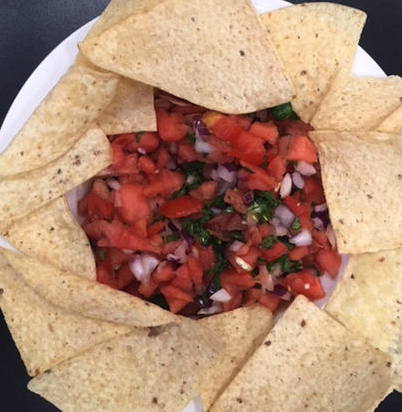
When The Washington Post was considering doing a feature story about my book, Diet Simple, among the recipes they tested was my chili. They loved it! The whole-front-page “Food” section feature was written. No one would ever guess my chili is healthy. That’s why I call it “stealthy healthy!”
Katherine’s Chili Non-Carne
(excerpted from Diet Simple: 195 Mental Tricks, Substitutions, Habits & Inspirations (LifeLine Press)
Try making this recipe a day ahead of time so the flavors and textures have a time to develop. I love this simple, quick chili recipe. It’s meatless but you don’t miss the meat because it’s so flavorful and the meat-like texture is deceptive. You should use the amount of garlic or chili powder that appeals to you. I like it hot and spicy! I double the recipe, using a whole pound of dried black beans, so I have plenty for the week. I use this dish as a lunch or dinner alongside a green salad. I also serve it at parties as a dip next to my fresh tomato salsa, nonfat Greek yogurt, and guacamole. It’s perfect rolled up in a tortilla or stuffed in a taco with some reduced fat cheese.
Serves 4 as a main course, 8 or more as a dip or topping
1/2 Cup Water (To Hydrate the Bulgur)
1/2 Cup Bulgur (Cracked Wheat)
1 Tbsp Olive or Canola Oil, or more
1 Large Onion, Chopped
3 Large Garlic Cloves, Minced (more or less)
3 Tbsp Hot Chile Powder (try 50/50 Chipotle Chili, maybe a dash of smoked paprika, called “Pimentón,” and just a pinch of Cinnamon)
1 Large Fresh Green Pepper, Chopped
1 28- oz. Can Italian Plum Tomatoes, chopped, including the liquid
1 Pound Can Kidney or Black Beans, whichever is preferred
2 Seeded Jalapeño Peppers, chopped, if desired
Salt and Pepper to Taste
Place the bulgur in a microwavable bowl. Add the boiled water. Place in microwave for 3 minutes. Keep in the microwave while it fluffs up. Meanwhile, sauté the vegetables.
Sauté the onions and garlic in the oil over low heat in a large pot until soft, 15 or more minutes. Add the chili powder and simmer for a few more minutes. Add the Fresh Green Pepper and cook until al dente. Add all remaining ingredients including the bulgur and simmer slowly over low to medium heat until flavors are well blended and vegetables are cooked to the desired consistency … a few minutes or longer, if desired. Adjust seasonings to your preference. Since many canned items were used, additional salt will probably not be needed.
Calories per serving 320, Total Fat 7g, Saturated Fat 1g, Carbohydrate 59g, Fiber 13g, Protein 12g
Katherine’s Spicy Fresh Mexican Salsa with Mild Guacamole
(excerpted from Diet Simple: 195 Mental Tricks, Substitutions, Habits & Inspirations (LifeLine Press)
Fresh salsa – Pico de Gallo – doesn’t really need a recipe. These are proportions I have found pleasing. But you may want your salsa, with more or less onions, more spice, sweeter (add watermelon), parsley instead of cilantro… The options are endless.
22 servings
Ingredients
1 large onion, peeled and chopped (about ½ pound)
2 lbs fresh tomatoes, peeled, seeded and chopped (start with about 3-1/2 lbs) (Use canned tomatoes, if good tomatoes aren’t available)
3 – 4 jalapeño peppers (1 – 2 ounces), to taste
¼ cup chopped fresh cilantro
½ tsp salt, or to taste
3 – 4 Tbsp fresh lime juice or the juice from 1 – 2 limes (optional. I often skip the limes)
Add the onion to the tomatoes. Finely chop 2 of the jalapeño peppers to start with. Taste. If you desire more heat, add 1 – 2 more jalapeños. Mix in the cilantro. Add the salt depending on your taste. Mix in the lime juice.
20 calories, 0g fat, 5g carb, 1g fiber, 1g protein
Katherine’s Guacamole
There a a million recipes for Guacamole. You can keep it mild, or make it hot by adding hot peppers. Throwing in fresh salsa makes it chunky and yummy, too.
12 Servings
Ingredients
2 ripe avocados
1/3 cup chopped fresh cilantro
2 Tbsp lime juice
¼ tsp salt, or to taste
freshly ground black pepper, to taste
Cut avocados in half lengthwise and pull out the pits. Scoop out the meat. Place ina medium bowl and mash, keeping some large chunks. Mix in the cilantro, lime juice, salt and pepper. Taste to adjust seasoning.
50 calories, 5g fat, 1g sat fat, 3g carbs, 2g fiber, 1g protein
7 Steps For Realistic, Achievable New Year’s Resolutions: A Second Chance!
- At January 20, 2019
- By Katherine
- In Articles, News
 0
0
The new year is a valuable opportunity to improve the quality of your life and happiness… Lose weight, eat healthfully, exercise… But most of us make impossible new year’s resolutions, and have given up by now. Does that describe you?
Don’t get me wrong. Resolutions are good. For instance, losing weight, eating more healthfully, being more physically active, are often essential life goals leading to increased energy, health and happiness.
But “losing weight” – or achieving any goal – means nothing without deciding on shrewd, small, concrete changes which can easily be incorporated into your daily routine. Look for approaches that complement, not dominate, your life.
Setting Goals, Keeping Goals
excerpted from “Diet Simple”
I can’t stress enough that goals should be fun and liberating, not just another ball and chain that weighs you down and reminds you of your failures. (We all have them, believe me!)
Everyone’s goals are different, of course. I don’t presume to have a one-size-fits-all set of goals that works for everyone. Over the years, however, I have developed some goal-setting strategies that I think will make a real difference.
For success, your goals should be:
Realistic. Perfectionistic goals set you up for failure.
Small, behavioral steps. You can’t set a goal of losing 2 pounds, but you can set a goal of doing the things that will cause you to lose 2 pounds. For instance, bringing a yogurt snack to work or adding delicious vegetable dishes to lunch and dinner.
Positive. Instead of stating what you won’t do (“I’ve got to stop eating chips every night”), state what you will do (“I’ll prepare a delicious fruit salad to snack on in the evenings”).
Flexible. Setting a goal to “exercise every day” may not be possible because of unforeseen circumstances. But saying instead, “I will be physically active 5 out of 7 days,” or “I will increase my daily pedometer steps by 2,000 this week,” is certainly do-able.
Measurable. “I’ll eat more fruits and vegetables,” is a noble goal, but how will you know when you reach it? Give yourself specific criteria so you can reward yourself for a job well done. “I’ll make a delicious vegetable batch recipe this weekend,” or “I’ll add a vegetable soup or salad to lunches this week.”
Important to you. Your goal must come from your heart, not your spouse’s or parent’s.
In a supportive environment. Does your home and work environment make healthful behaviors easier or harder? Do you need to have healthful, tasty, ready-to-grab foods in your refrigerator? Do you need your spouse to participate more fully with your healthy lifestyle? Take a look at your environment to determine if it is supportive enough and you have the tools you need to achieve your goals.
The battle of the bulge will be won at the margins. Sweeping changes are impractical and won’t work!
This article is excerpted from my book, “Diet Simple.”

